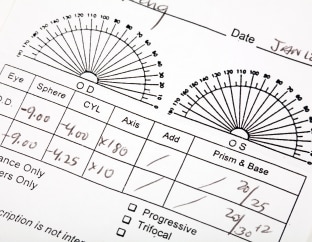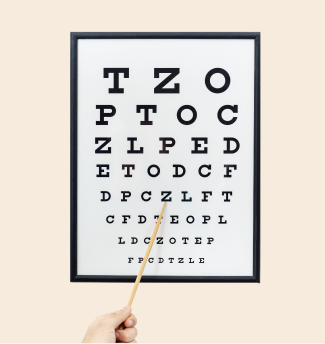How to Read a Glasses Prescription
Knowing how to read an eyeglass prescription is essential! While you likely know whether you’re nearsighted, farsighted or have astigmatism, determining that from your prescription slip is another thing entirely. That’s why we’ve put together a short guide to help you learn how to read a glasses prescription so you can get to ordering your new set of eyeglasses as quickly as possible.
If you complete an eye exam and find your eyes’ needs have changed, you need to order a new prescription as soon as possible. That’s where your new prescription from your optometrist or ophthalmologist comes in.
Most online retailers ask you to read and input your prescription into their order form, but if you don’t know how to read your prescription, that process can get complicated.
What do all these letters and numbers mean?
The numbers on your eyeglass prescription describe precisely how your glasses lenses should be cut. Keep your prescription up to date so these numbers can accurately reflect your visual needs. Typically, you’ll see several abbreviations and words labeling all of the important data on your prescription. See below to learn the meaning of SPH, CYL Axis, Prism, PD, and more.

OD vs. OS Eye
OD is short for the Latin term oculus dexter which means right eye.
OS is an abbreviation of the Latin oculus sinister which means left eye. You’ll often see this terms on eyeglass prescriptions.
Sphere, Cylinder, and Axis on Eye Prescriptions
Sphere: The sphere (SPH) on your prescription indicates the lens power you need to see clearly. A minus (-) symbol next to this number means you’re nearsighted, and a plus (+) symbol means the prescription is meant to correct farsightedness.
Cylinder: The cylinder (CYL) number indicates the lens power needed to correct astigmatism. If this column is blank, it means you don’t have an astigmatism.
Axis: An axis number will also be included if you have an astigmatism. This number shows the angle of the lens that shouldn’t feature a cylinder power to correct your astigmatism.
-
Nearsighted prescriptions
A nearsighted prescription will feature a number with a minus (-) symbol in the ‘sphere’ box. This means your lenses will be shaped to improve your distance vision.
Glasses PrescriptionPatient Expiration dateDistance OD OS Sphere Cylinder -4.00 -5.00 -0.50 Axis Prism 180 Base Add Pupilary distance (PD):62Additional information:Hover on the prescription form to find out what all those number and abbreviations mean -
Farsighted prescriptions
A prescription for someone who is farsighted will feature a number with a plus (+) symbol in the ‘sphere’ box. This indicates that your lens should be shaped to correct near vision.
Glasses PrescriptionPatient Expiration dateDistance OD OS Sphere Cylinder +2.00 +2.00 -0.50 Axis Prism 180 Base Add Pupilary distance (PD):62Additional information:Hover on the prescription form to find out what all those number and abbreviations mean -
Astigmatism prescriptions
If you have an astigmatism, you will have a number in the ‘cylinder’ column of your prescription that indicates the lens power needed to correct the astigmatism. There will also be a number in the ‘axis’ column that’s needed for astigmatism correction.
Glasses PrescriptionPatient Expiration dateDistance OD OS Sphere Cylinder -4.00 -5.00 -0.50 Axis Prism 180 Base Add Pupilary distance (PD):62Additional information:Hover on the prescription form to find out what all those number and abbreviations mean -
Bifocal & progressive prescriptions (multifocal)
A multifocal prescription will include an ADD value, sometimes marked as NV. This indicates the required strength for the near prescription in your lens.
Glasses PrescriptionPatient Expiration dateRX Multifocal OD OS Sphere Cylinder -4.00 -5.00 -0.50 Axis Add +2.00 180 +2.00 Pupilary distance (PD):62Additional information:
Near PD:59Hover on the prescription form to find out what all those number and abbreviations mean -
Prescriptions with prism correction
A prescription for correcting eye alignment issues will include a PRISM and BASE value. These are needed to tell us how to shape the lens so that it can accurately align the wearer’s eyesight. The base value will show either “in” or “out”, or “up” and “down”, indicating the direction the prism should be angled.
Glasses PrescriptionPatient Expiration dateDistance OD OS Sphere Cylinder -4.00 -5.00 -0.50 Axis Prism 180 Base Add down +2.00 up +2.00 Pupilary distance (PD):62Additional information:Hover on the prescription form to find out what all those number and abbreviations mean

How often should you get an eye exam?
If you don’t have any medical issues that affect your vision, you should have a comprehensive eye exam every one to two years.
Children should have their first eye exam when they are around six months old, and then another just before they start school. This ensures that they can see clearly in class; poor vision can seriously impact a child’s learning
Now that you understand those mysterious letters and numbers, you know how to read a glasses prescription! Knowing what they mean will also help you more easily discuss your prescription with your eye care professional.






